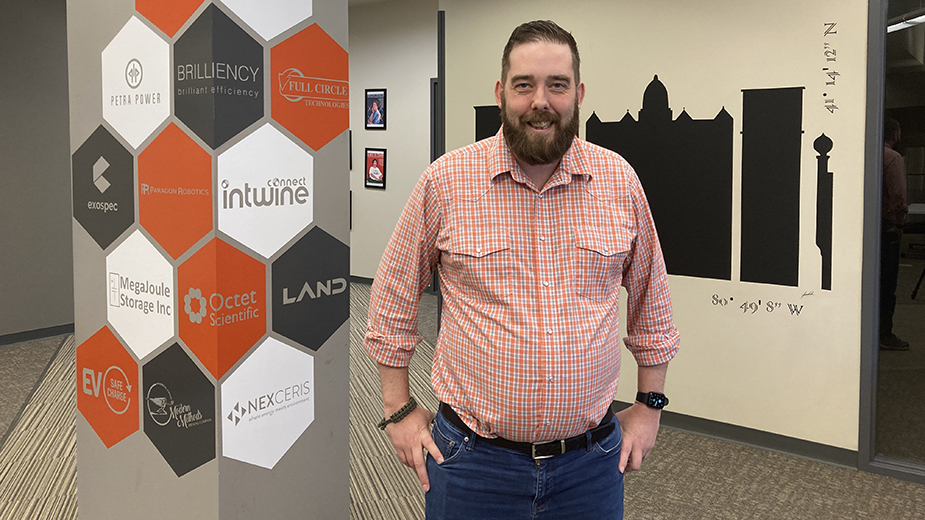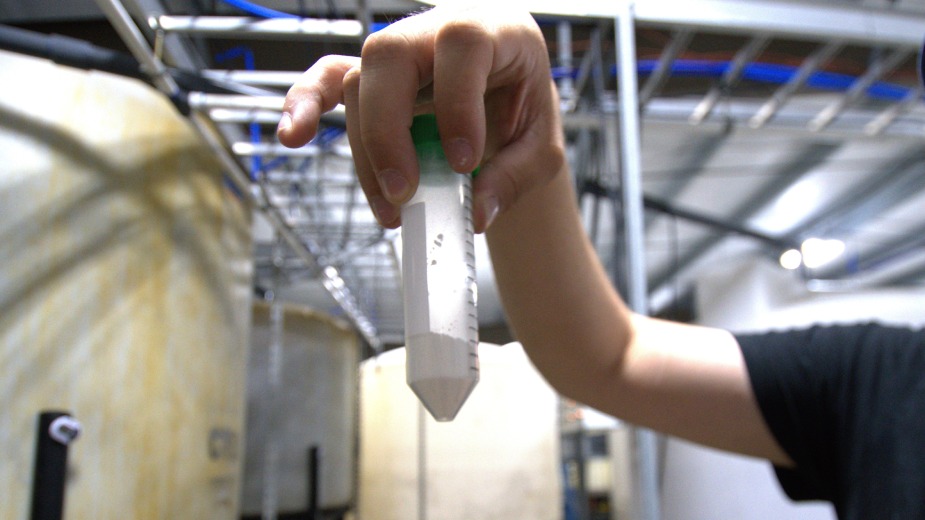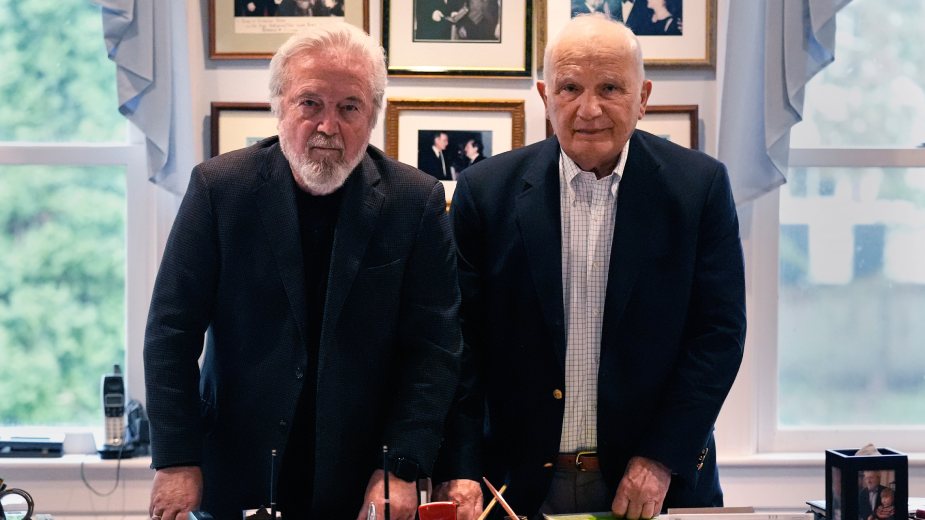Energy Incubator is a Brite Spark for Voltage Valley
WARREN, Ohio – Rick Stockburger is a man constantly on the move these days.
Three weeks ago he was in Washington, D.C., as a member of the board of the Clean Tech Incubator Coalition. In mid-March, he’s expected to deliver a talk at the InterBattery conference in Seoul, South Korea. Then, it’s back to Washington before he heads to Phoenix to participate in an Incubatenergy Labs program.
And in May, Stockburger travels to Denver to address the annual Industry Growth Forum.
“Conference season has begun,” says Stockburger, CEO of Brite Energy Innovators in Warren. That organization in downtown Warren is the sole incubator dedicated to energy startup companies in the state of Ohio.
GETTING THE WORD OUT
This time of year, Stockburger routinely embarks on a frenetic schedule of shuttle diplomacy that takes him all across the country and beyond. His message is simple and straightforward: to extol the benefits and opportunities of the Mahoning Valley – a region dubbed “Voltage Valley” because of innovative projects underway in the renergy sector.
“In Seoul, I’ll be speaking about shoring manufacturing here in the U.S. and why Voltage Valley is the best place in the world to build batteries and electric vehicle-allied technologies,” Stockburger says. “It’s the largest battery conference in Asia.”
Founded as the Technology Belt Energy Innovation Center, or TBEIC, in 2010, Brite has emerged as a locus for energy startups from all over the state. Today, Brite serves 80 early stage companies, nearly 20 of which are physical tenants in its building on East Market Street.
Indeed, the incubator in Warren has extended its reach far beyond Voltage Valley, Stockburger says. It’s helped nearly 600 companies and recent metrics show that Brite has raised approximately $300 million in venture capital and public investment.
That’s the third-best in the country when it comes to raising venture capital among energy incubators, Stockburger says.
“We’re behind Greentown Labs in Boston and the Los Angeles Green Tech Incubator,” he says.
Not bad for an incubator in the Midwest that operates on an approximately $2 million annual budget funded through a mix of federal, state and philanthropic sources.
Brite targets early-stage energy companies that are engaged in mobility, energy storage and grid resiliency, Stockburger says. His organization provides these young firms with office space, lab equipment, and business mentoring and consulting services to help take their research and development to the commercial level.
Moreover, it’s Brite’s objective to build an energy-product hub that will thrive in the region, attract new jobs, lure additional companies and plug the “brain drain” that has long siphoned talent from the Mahoning Valley to other parts of the country.
“Over the last 20 years, our greatest export has been talented young people,” he says.
To illustrate this, Stockburger makes it a point to wear t-shirts emblazoned with “Warren” at the many conferences he’s asked to attend.
“People come up to me and say ‘Warren? I’m from Howland,’ or ‘I’m from Champion,’” he says. Once they hear about Brite, they become intrigued about opportunities in the Valley that did not exist two decades ago.
“I see it turning into boomerang opportunities,” Stockburger says. “As coastal areas such as San Francisco become too expensive, why not come home?”
Central to the region is the emerging electric-vehicle segment and its potential for spinoff development.
Anchored by Ultium Cells LLC’s new EV battery-cell production plant in Lordstown, as well as Foxconn’s electric-vehicle contract manufacturing operation nearby, the Mahoning Valley is in a strong position to attract additional energy-related opportunities, he says.
“We made steel for the rest of the world,” Stockburger muses, reflecting on the region’s steel manufacturing legacy. “We can make EVs for the rest of the world. We can make batteries for the rest of the world.”
FUNDING VOLTAGE VALLEY
A critical component of building a stream of innovative energy companies is establishing a business case for their new products. Then, it’s part of Brite’s job to match these new companies with investors able to leverage their value.
Upon arriving as Brite’s CEO five years ago, Stockburger took an inventory of other energy incubators around the country. While these organizations teemed with brilliant scientists, chemists and technology specialists, few of them had programs that promoted business development.
“Brite is built around business development,” Stockburger says. As such, Brite often acts as the conduit between portfolio companies and potential sources of funding from both the private and public sectors, he says.
One challenge is there isn’t a rich vein of venture capital opportunities in the Mahoning Valley, or the Midwest, for that matter, Stockburger says.
“I’ve got to arrange a meeting from the coast, making sure the company is something they need,” he says. “Then, make an introduction. Often, it’s valuable for both sides and leads to an investment.”
Among those portfolio companies that recently won new investment is Petra Power, a tenant firm that is commercializing technology first developed at the NASA Glenn Research Center in Cleveland.
“Brite has been invaluable in our ability to exist,” says Aaron Goodman, CEO and co-founder of Petra Power. The company produces solid-oxide fuel cells. These are cells that convert fuel to electricity without burning it.
Goodman says Stockburger convinced the small company to relocate from Wyoming to Warren, where it was closer to Glenn Research and could benefit from the resources Brite provides.
“Our company was boot-strapped,” he says.
The incubator enabled the company to focus on product development through shared use of its laboratory and generous lease terms for office space.
More important, Brite was able to facilitate connections between Petra Power and funding sources, Goodman says.
In the last month, Petra received a federal government award to the tune of “multimillions of dollars” over the next two years. This money, he adds, will help lead to proving the commercial viability of the Petra Power product.
The company’s first commercial-target sector is the transportation industry, Goodman says, specifically Class 7 long-haul trucks with large electrical loads. Petra Power’s fuel cells supplement the vehicle’s engine and produce electricity that powers other operations in the truck, such as heating, ventilation and air conditioning, lights and radio.
“The auxiliary unit operates the electrical power of the truck,” Goodman says.
Moreover, the power produced by the unit is 80% more efficient and reduces the vehicle’s fuel consumption considerably. These units operate on the same type of fuel used in the vehicle, whether it’s diesel gas, hydrogen, propane gas or natural gas, he says.
Petra Power employs three, but expects to employ as many as 20 at the end of its two-year contract, Goodman says. Future uses of its product could include emergency backup power services or distributed power systems, he says.
NURTURING INNOVATION
Other companies working at Brite see the organization as an important laboratory to nurture innovation in the energy sector.
“We came to Brite about three years ago,” Alex Zorniger says. Zorniger is vice president of business development at Power to Hydrogen, based in Columbus.
The company has perfected technology that allows for the clean production of hydrogen from renewable energy sources, he says. This hydrogen is then used for industrial applications, such as glass manufacturing, fertilizer production and other segments.
“The industrial market is a $100 billion market,” Zorniger says.

The company has developed an electrolyzer that inducts electricity through water so it can create hydrogen. “Electrolyzers have been expensive to make in the past,” Zorniger says. The vast majority of hydrogen today is produced through the conversion of methane gas.
This process, however, expels a significant amount of CO2 into the atmosphere, according to Zorniger.
“Right now, between 2% and 3% of CO2 emissions come from the production of hydrogen,” he says. “We’re trying to replace this process and make hydrogen from water and renewable electricity generated from wind or solar.”
The goal is to produce clean hydrogen at a cheaper cost. The company is conducting its first pilot project at Brite. “We started testing 45 days ago,” Zorniger says.
Power To Hydrogen’s first customer is Enel Green Power S.p.a., an Italian multinational corporation based in Rome that is also the largest installer of renewable energy systems outside of China.
“We were looking for a third-party laboratory and decided to install our production equipment at Brite,” Zorniger says. “They’re easy to work with, far less bureaucratic. They’ve also been very helpful to introducing us to investors and refining our presentation.”
NEXT STEPS FOR VOLTAGE VALLEY
It’s important to reach out to small as well as medium-sized companies, Stockburger says, to place them in a position to harness as much funding as possible.
Such is the idea of building the Brite Network, an effort underway at the incubator to engage these companies and introduce them to potentially lucrative funding sources, especially the federal government.
“There are billions and billions of dollars through the U.S. Department of Energy that are coming down right now,” Stockburger says.
Much of this money is targeted toward clean energy demonstration projects, he says, perfect for Brite’s clients. “We have strong ties with the DOE.”
Two former deputy secretaries of Energy are on the staff and board of Brite, Stockburger says. And, a former board member now works at the department in a leadership position.
He says the Mahoning Valley has the opportunity – its utility costs are comparatively less expensive than other areas of the country, and Ohio is a business incentives-friendly state – to secure additional supply-chain companies related to EV battery development.
“Cathode and anode production, for example, should be on our radar screen,” Stockburger says, since these companies won’t qualify for federal incentives unless they are located in the United States.
“We’ll have to be better than Tennessee or Michigan,” he says, citing the two states where Ultium Cells plants are under construction. “One of these places will win the majority of it.”
The Voltage Valley – buttressed by Ultium and Foxconn, as well as ambitious training initiatives with partners such as Youngstown State University and Eastern Gateway Community College – is in a strong position to assume a leading role as the EV industry and energy tech sector matures.
“This community deserves every dollar it can get and be at the forefront of the energy revolution,” Stockburger says.
Pictured at top: Rick Stockburger will travel to South Korea this month for a battery industry conference.
Copyright 2024 The Business Journal, Youngstown, Ohio.



